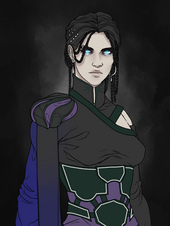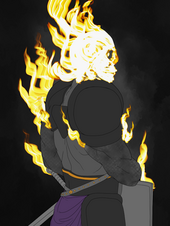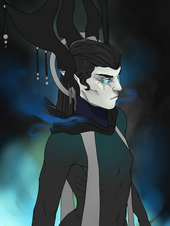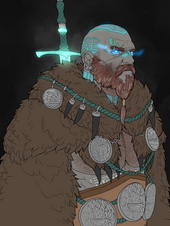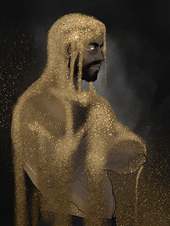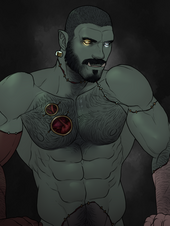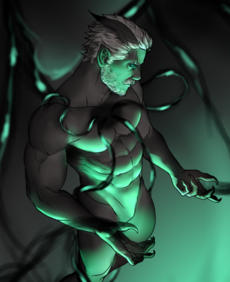Undead: Difference between revisions
(Removed redirect to Bintaar#Undead) Tag: Removed redirect |
|||
| (102 intermediate revisions by 6 users not shown) | |||
| Line 1: | Line 1: | ||
{{Info | {{Info afflictions | ||
|image | |image = Undead.png | ||
| | |races = All, though some can avoid it. | ||
|origins = Unknown | |||
| | |||
|}} | |}} | ||
The | The stuff of nightmares for some, figments of folklore for others, and the steadfast guardians of ancient faith to even fewer, Undead are a barely understood Affliction that has started wreaking havoc in Aloria in the past century or so, leaving scholars unable to figure out why. Undead take a variety of different forms, often dictated by the faith and belief they held in life as they are barred from the gates of the afterlife, but they share a common trait in being damned by the living for their very existence is a revolt against nature and the cycle of life and death. The Undead struggle to exist in a world that is so strongly against them, always forced to carve something with a semblance to normality on the edges of society, always hunted by the forces of religious virtue, even if they have done nothing wrong, and are themselves the victim ill-will of others. As Undeadism across the world is becoming worse with each passing year, both the living and Undead are forced to grapple with the arising morality of Undeath, and the subsequent violence that is erupting over these questions. Playing an Undead is not recommended for new players, as Undead are almost universally hunted by all Races and Religions, with very few exceptions. Roleplaying as an Undead results in hostility from other Characters, and roleplay opportunities are denied with unrelenting opposition. Undeath (unlike in some other lore universes) is not a Race of its own, and rather just builds on existing Races. You may convert a living Character into an Undead at any time. Resurrecting a past character that died some time ago, will require approval from Lore Staff. | ||
Undead | |||
==Core Concept== | |||
===Becoming Undead=== | |||
In Aloria, all living things have a body and soul bound together through some unknown force. A soul can only ever belong to one body, and even though some Magic exists to remove a soul from a body without destroying it, by far and large the majority of people who die in Aloria pass into the afterlife. For some, however (and with increasing frequency), their souls are unable to pass into the afterlife, or only briefly do so before being forced to re-inhabit their bodies. When a soul has been severed from its body, even if it returns later, a state of Undeath occurs, where the body is technically still functioning and controlled by the soul, but the merger is imperfect, decay has set in, the body no longer needs to eat, sleep, or breathe, and a variety of things can happen. First, examine the manners by which one can become Undead: | |||
* '''Violenced Undeath:''' is a common form of Undeath, and one that has been researched but few have any understanding of. In many recorded instances, a person came to a violent end in either extreme tragedy or anger, and as a result became Undead, awakening shortly after death had set in. | |||
* '''Unfinished Undeath:''' is an equally common form of Undeath, where a person had such a strong connection to unfinished business in life that their soul refused to pass into the Afterlife and returns to the body. This may also occur if a person dies just before the conclusion of earthly business. | |||
* '''Forced Undeath:''' is a less common form of Undeath, that involves a person being forced to become an Undead. This can happen through a variety of means, for example Ordial rituals, Ordvaan Rituals (see Deathwatch Undead), Rituals of the Bone King, or Death Isldar rituals that deny the Afterlife to the soul. | |||
* '''Gateshut Undeath:''' is a very rare form of Undeath, that follows a soul being actively rejected by their Afterlife for religious reasons. A good example of this is Fornoss Undead, who are rejected from the Afterlife by their Gods because their Soldi or Svaldi is so low (though it also may occur due to the gods fighting over the rights to a soul, thus trapping them in Undeath for the course of the arguments). | |||
===Perception of Death=== | |||
To most Religions of Aloria, Undeath is a perversion of faith, because most faiths have the principle of divine judgement, where a person's soul shall be judged by a God of the afterlife, and deemed worthy to paradise. The logic that many faithful uphold, is that any type of Undead they meet, must have been rejected by their god and is therefor an immoral and sinful being, or one who actively wanted to avoid the judgement of their God and thus commit blasphemy. The reality is more complicated however, as the vast majority of the Undead did not ask to become Undead, or worse, were forced into by other more nefarious individuals. Undeath has only really become a major problem in the last 40 years with the rate of Undeath exploding exponentially each year. Undeath has existed for as long as death and life were a thing on Aloria, with references found even in Seraph murals, but it was always a fringe issue, until the gruesome murders at the Imperial Palace that saw all the sons of Emperor Justinian II slain by an outbreak of Undeath in the Palace itself. Since then, most faiths and societies have adopted anti-Undeath burial practices, like cremation and beheading before burial (the latter of which prevents Undeath from ever taking place). | |||
==Types of Undead== | |||
== | There exist multiple types of Undead, usually categorized based on Religions, as each Afterlife has different rules for entry (and those who are rejected). These types provide general "theme traits", which should be respected, but Players have a great deal of freedom beyond the standard. For example, if the requirement for Unionist Undead is just to have glowing eyes and pale skin, Players have the freedom to add more, so long as they don't detract the minimum that is there. As a general rule, no form of Undeath can make a person appear like any normal person. Afflictions cannot be hidden, Undeath being more so because Undead do not have basic body biology function. Note, they don't still need to believe in these Religions, Undead often lose their faith due to being refused by their old communities. Atheist and Ordial Cultist Undead move on straight to Deathrot. Is is important to note that if one of the Types states it is accepted by a particular religion, it means they won't be attacked on sight by them, but the law is still very much against them and they will have other enemies. | ||
<table style="width: 100%;"><tr><td style="width: 33%; vertical-align: top; text-align: left;"> | |||
{| | |||
|[[File:Unionismundead.png|170px|thumb|left]] | |||
| | |||
<span style="font-size:130%;><center>'''Mortis Undead'''</center></span> | |||
Mortis Undead are very common among Unionists, but not bound to any specific Religion and generally seen as the "default" Undead for those who do not want the cultural or thematic connections the other Undead Types have. Mortis Undead start with only two notable traits: glowing eyes of whatever eye color their eyes were before death/milky white opaque eyes, and a much paler skin/darkened eye sockets. Over time, Mortis Undead can rot, stay roughly the same, or need new body parts to amend those that were lost. | |||
|} | |||
</td><td style="vertical-align: top; width: 33%;"> | |||
{| | |||
|[[File:Burningchoir.png|170px|thumb|left]] | |||
| | |||
<span style="font-size:130%;><center>'''Burning Choir Undead'''</center></span> | |||
Burning Choir Undead are exclusive to [[Unionism]]. These Undead are formed when devout Unionists die in service of the Emperor or the faith, for example Knights or soldiers or priests themselves. Burning Choir Undead are always a skeleton enveloped in flames, usually golden, but other colors too. Burning Choir Undead are still seen as anathema by the priesthood, but some among the Unionist population secretly help them. with their service in undeath. | |||
|} | |||
</td><td style="vertical-align: top; width: 33%;"> | |||
{| | |||
|[[File:Estellonundead.png|170px|thumb|left]] | |||
| | |||
<span style="font-size:130%;><center>'''Deathwatch Undead'''</center></span> | |||
Deathwatch Undead are exclusive to [[Estelley]], always created rather than spontaneously risen. These Undead are created by the Rite of Ammuloa, performed by a Ordvaan, who plunges a ritual dagger into their heart during a ceremony, binding them in eternal service as a protector to a place, person, or family, creating Deathwatch Undead who remain clean and unaffected by mutations, save for glowing eyes and porcelain skin color. These Undead are tolerated by the Estelley faithful. | |||
|} | |||
</center> | |||
</tr></table> | |||
<table style="width: 100%;"><tr><td style="width: 33%; vertical-align: top; text-align: left;"> | |||
{| | |||
|[[File:Oldgodsundead.png|170px|thumb|left]] | |||
| | |||
<span style="font-size:130%;><center>'''Draugr Undead'''</center></span> | |||
Draugr Undead are the mortal enemies of the [[Fornoss]] faithful, rejected from the afterlife by various means, but most commonly some dispute over their soul, or improper burial practices. All Draugr have gray skin and their (often) Velheim tattoos and eyes glow, but further rot and mutations can take place. Draugr Undead are particularly hunted by the Fornoss faithful who mostly ignore other Undead, because these Undead in particular often must be put to rest. | |||
|} | |||
</td><td style="vertical-align: top; width: 33%;"> | |||
{| | |||
|[[File:Sadunssdead.png|170px|thumb|left]] | |||
| | |||
<span style="font-size:130%;><center>'''Saydir Undead'''</center></span> | |||
In Farahdeen, there are many dead and undead things, Saydir Undead being one of them. The Saydir are Sariyd dead whose souls became trapped in a pseudo-sand-and-body state, where part of their body spontaneously shift to sand, seep away, before reforming, with sand trickling from most body parts. Saydir are hunted by Qadir and Songaskians alike to put them out of their misery, as they live in the eternal knowledge of all that they have lost, their emotional instability contributing to the deluge of sand slides. | |||
|} | |||
</td><td style="vertical-align: top; width: 33%;"> | |||
{| | |||
|[[File:Foreborn.png|170px|thumb|left]] | |||
| | |||
<span style="font-size:130%;><center>'''Foreborn Undead'''</center></span> | |||
Foreborn Undead come from a mixture of [[Baskarr]] Religion and certain scientist cults, both of which are protective and supportive of the Foreborn Undead. Foreborn Undead have been judged as "serving the dead" by their respective Gods, for the Asha recovering the past, and for these cults rejecting Magic dominance, both aligned on the fight against the Allorn Elves. Foreborn Undead are exceptionally unstable due to their physical power often ripping their body apart, needing frequent replacements. | |||
|} | |||
</center> | |||
</tr></table> | |||
==Deathrot== | |||
[[File:Sadsad.png|230px|thumb|right|A Deathrotten Mortis Kul.]] | |||
Deathrot is a process that threatens every Undead at some point or another and causes some of them to become Ordial Corrupted. Undead, no matter how strong their belief in their religion, or their mental fortitude, struggles with a constant urge to slide towards hatred of the living, envy of being what they can never return to, or rage against the Gods for having permitted this. In the Beyond, a malicious entity known as the Malefica (found in [[Ordial Cultism]] preys on this, trying to infect the mind with such intense hatred of the living, that they let Ordial power into their body and soul. When this occurs, this is called Deathrot, which sets in a slow but steady spiral, culminating to the individual completely being corrupted by the Beyond and becoming an agent of death of the Beyond. Many Undead face a constant battle with this creeping hatred in their heart, with exclusion and violence inflicted on them from their old societies and often friends and family, tipping them over the edge. Deathrot coincides with steady increases in Ordial mutations, with aesthetics slowly shifting towards Ordial the more Deathrot sets in, including Ordial green eye colors, bone protrusions, ghostly effects and more. Deathrot can be a fast process that only takes weeks, but for some Undead it can take decades if not centuries. When Deathrot sets in, the Dimensional Alignment of the Undead swaps to Ordial, meaning any Void or Exist Abilities will become Ordial instead. Atheist and Ordial Cultists who become Undead start Deathrot immediately. Becoming infested with an Ordial Shade of any kind also sets in Deathrot, or at the very least forces the Undead to become Ordial Aligned. Deathrotting Undead do not have to specifically align with the Malefica or be Ordial Cultists. They can at any point in time align with a different Ordial Entity, or simply fester and derive power from the hatred in their heart. Deathrot does also not necessarily make an Undead unequivocally evil, or always a hateful person. Hate can express itself in remorse, grief, or envy towards the living, or even just resentment over how they were treated, hunted, and often put down without recourse or mercy. In this way, Deathrot represents a detachment from living society and a will to make a society for the Undead, or find some way to punish the living for what they have done to the Undead, and continue to do to them. Deathrot can also be halted, by a return to faith, or outside factors like a Deathrotting Undead finding love among the living. Ordial Alignment can never be taken away, but by temporarily halting Deathrot, the Undead can let go of their hatred and violence towards the living, and live a reasonable normal life of undeath. | |||
===Afflicted Form=== | |||
Afflicted Form is a Transformation that can be used by Deathrotting Undead for a variety of reasons ranging from disguise to a surrender to hateful emotions and look cool in combat. Afflicted Forms are more monstrous forms of their normal body, and allow some more creative freedom like making the Character appear more like a hulking beast, so long as it remains vaguely humanoid, and should not add additional function (like wielding more than one weapon with multiple arms). Afflicted Form cannot imitate other types (like Vampire or Marken), and must always remain the same, and be predominantly green or Ordial-themed. | |||
==Undead Traits== | |||
This section puts all Abilities, Free Packs, Limitations, and Mechanics together for ease of reference. Keep in mind, Afflictions are not Races, these Traits are additive, they do not replace Racial Traits. | |||
===Abilities=== | |||
{| class="wikitable" style="width:50%;" | |||
|- style="font-weight:bold; text-align:center; background-color:#c0c0c0;" | |||
! Ability Name | |||
! Ability Type | |||
! Ability Range | |||
! Ability Description | |||
! Modifiers | |||
|- | |||
| style="background-color:#e5ffcc;" | Chem Revive | |||
| Active Technique | |||
| {{#simple-tooltip: Emote Range | Emote Range means that it can target anyone who is within Emote Range (thus who can see your emotes when you use them).}} | |||
| Grants the user {{#simple-tooltip: Chem Revive | To empower an Ally, Target them with this Ability. If the Ally reaches 0 HP, they are instead revived with 2 temporary HP, and given 4 more Attack Emotes. If any of these Attack Emotes was able to put an enemy down to 0 HP, the 2 temporary HP is converted to permanent HP, and they heal an additional 1 HP. If they fail to put an enemy to 0 HP, the temporary HP is removed, and they KO properly. This Ability cannot be used on a person already affected by a Revive Ability (Sacred Revive, Chem Revive, etc). Chem Revive has a 2 Hour Cooldown. | |||
}} | |||
| {{#simple-tooltip: Undead Modifier | Undead cannot use this Ability on anyone but themselves. Instead, this Ability is always active (meaning they do not need to use it), and automatically triggers when they go to 0 HP. Also, this Ability has a 1 Hour Cooldown for Undead instead of 2 Hours. | |||
}} | |||
|- | |||
|} | |||
===Limitations=== | |||
* '''Undead Limitation I:''' Bralona, and Suvial cannot be Undead under any circumstances. Undead also cannot become other Afflictions, or [[Marken]] or [[Archon]]. | |||
* '''Undead Limitation II:''' Affinities not blocked like [[Arkenborn]] and [[Godborn]] lose their Traits upon becoming Undead. Some visuals may also have to change. | |||
===Mechanics=== | |||
* '''Undead-Life:''' Undead are not immortal, but their life is extended by several centuries, up to a maximum of 500. There are in theory older Undead, but we do not permit players to play 500+ year old Characters. | |||
* '''Undead-Forge:''' Undead are able to apply Ordial aesthetics and decorations on objects they own, armor, weapons, rental regions, and areas around them, creating undead effects and decorations. | |||
* '''Undead-Biotic:''' Undead no longer need biological processes. They do not breathe, do not need to drink or eat, sleep, or rest, and cannot be fed from by Vampires or Geists. | |||
* '''Undead-Graft:''' Undead can add objects and body parts removed from other living or Undead to repair parts of their body, meaning they can heal themselves while outside of Combat and recover lost limbs. | |||
===Deathrotten-only Mechanics=== | |||
* '''Undead-Speech:''' Undead are able to communicate in a secret language that only Undead, Geists and Geist-Thralls and Geist-Broods can understand, that cannot be understood through other Abilities or Mechanics. | |||
* '''Deathrot-Form:''' Undead can use Afflicted Form to transform into a Disguised Monster Form. Even though this is a Disguise, it cannot be seen through, even by Abilities or Mechanics that can see through Disguises. | |||
==Trivia== | ==Trivia== | ||
* | *In places where necromancy is either legal or looked over, some necromancers turn a very healthy profit by resurrecting the dead pets of the wealthy who can’t bear to be parted from their favorite companions. It should be noted however, that these pets are not Undead, but rather Ordial Shades forced into corpses as Spirits. | ||
* | *With the rise in publicity of knowledge about Ordial powers and Deathrotten Undead, so too has the paranoia of those who hate them risen, leading the most radical of conspiracy theorists to believe that the Regalian Empire may be entirely controlled by phantom-possessed people. | ||
* | *A rumor for nearly two decades after it happened was that the Emperor couldn’t bear to kill his last remaining son, despite his Undead status. Instead, he kept him chained and secured away in the deepest reaches of the Imperial Palace. | ||
{{ | {{Afflictions}} | ||
{{Accreditation | {{Accreditation | ||
|Writers = | |Writers = MonMarty | ||
|Processors = | |Processors = Birdsfoot_Violet | ||
}} | }} | ||
[[ | [[category:Afflictions]] [[category:Ordial Afflictions]] | ||
Latest revision as of 16:20, 31 December 2023
| Undead | |
|---|---|
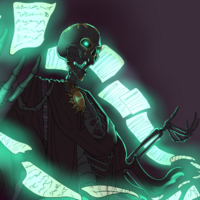 | |
| Afflictions | |
| Affected Races | All, though some can avoid it. |
| Origins | Unknown |
The stuff of nightmares for some, figments of folklore for others, and the steadfast guardians of ancient faith to even fewer, Undead are a barely understood Affliction that has started wreaking havoc in Aloria in the past century or so, leaving scholars unable to figure out why. Undead take a variety of different forms, often dictated by the faith and belief they held in life as they are barred from the gates of the afterlife, but they share a common trait in being damned by the living for their very existence is a revolt against nature and the cycle of life and death. The Undead struggle to exist in a world that is so strongly against them, always forced to carve something with a semblance to normality on the edges of society, always hunted by the forces of religious virtue, even if they have done nothing wrong, and are themselves the victim ill-will of others. As Undeadism across the world is becoming worse with each passing year, both the living and Undead are forced to grapple with the arising morality of Undeath, and the subsequent violence that is erupting over these questions. Playing an Undead is not recommended for new players, as Undead are almost universally hunted by all Races and Religions, with very few exceptions. Roleplaying as an Undead results in hostility from other Characters, and roleplay opportunities are denied with unrelenting opposition. Undeath (unlike in some other lore universes) is not a Race of its own, and rather just builds on existing Races. You may convert a living Character into an Undead at any time. Resurrecting a past character that died some time ago, will require approval from Lore Staff.
Core Concept
Becoming Undead
In Aloria, all living things have a body and soul bound together through some unknown force. A soul can only ever belong to one body, and even though some Magic exists to remove a soul from a body without destroying it, by far and large the majority of people who die in Aloria pass into the afterlife. For some, however (and with increasing frequency), their souls are unable to pass into the afterlife, or only briefly do so before being forced to re-inhabit their bodies. When a soul has been severed from its body, even if it returns later, a state of Undeath occurs, where the body is technically still functioning and controlled by the soul, but the merger is imperfect, decay has set in, the body no longer needs to eat, sleep, or breathe, and a variety of things can happen. First, examine the manners by which one can become Undead:
- Violenced Undeath: is a common form of Undeath, and one that has been researched but few have any understanding of. In many recorded instances, a person came to a violent end in either extreme tragedy or anger, and as a result became Undead, awakening shortly after death had set in.
- Unfinished Undeath: is an equally common form of Undeath, where a person had such a strong connection to unfinished business in life that their soul refused to pass into the Afterlife and returns to the body. This may also occur if a person dies just before the conclusion of earthly business.
- Forced Undeath: is a less common form of Undeath, that involves a person being forced to become an Undead. This can happen through a variety of means, for example Ordial rituals, Ordvaan Rituals (see Deathwatch Undead), Rituals of the Bone King, or Death Isldar rituals that deny the Afterlife to the soul.
- Gateshut Undeath: is a very rare form of Undeath, that follows a soul being actively rejected by their Afterlife for religious reasons. A good example of this is Fornoss Undead, who are rejected from the Afterlife by their Gods because their Soldi or Svaldi is so low (though it also may occur due to the gods fighting over the rights to a soul, thus trapping them in Undeath for the course of the arguments).
Perception of Death
To most Religions of Aloria, Undeath is a perversion of faith, because most faiths have the principle of divine judgement, where a person's soul shall be judged by a God of the afterlife, and deemed worthy to paradise. The logic that many faithful uphold, is that any type of Undead they meet, must have been rejected by their god and is therefor an immoral and sinful being, or one who actively wanted to avoid the judgement of their God and thus commit blasphemy. The reality is more complicated however, as the vast majority of the Undead did not ask to become Undead, or worse, were forced into by other more nefarious individuals. Undeath has only really become a major problem in the last 40 years with the rate of Undeath exploding exponentially each year. Undeath has existed for as long as death and life were a thing on Aloria, with references found even in Seraph murals, but it was always a fringe issue, until the gruesome murders at the Imperial Palace that saw all the sons of Emperor Justinian II slain by an outbreak of Undeath in the Palace itself. Since then, most faiths and societies have adopted anti-Undeath burial practices, like cremation and beheading before burial (the latter of which prevents Undeath from ever taking place).
Types of Undead
There exist multiple types of Undead, usually categorized based on Religions, as each Afterlife has different rules for entry (and those who are rejected). These types provide general "theme traits", which should be respected, but Players have a great deal of freedom beyond the standard. For example, if the requirement for Unionist Undead is just to have glowing eyes and pale skin, Players have the freedom to add more, so long as they don't detract the minimum that is there. As a general rule, no form of Undeath can make a person appear like any normal person. Afflictions cannot be hidden, Undeath being more so because Undead do not have basic body biology function. Note, they don't still need to believe in these Religions, Undead often lose their faith due to being refused by their old communities. Atheist and Ordial Cultist Undead move on straight to Deathrot. Is is important to note that if one of the Types states it is accepted by a particular religion, it means they won't be attacked on sight by them, but the law is still very much against them and they will have other enemies.
|
|
|
|
|
|
Deathrot
Deathrot is a process that threatens every Undead at some point or another and causes some of them to become Ordial Corrupted. Undead, no matter how strong their belief in their religion, or their mental fortitude, struggles with a constant urge to slide towards hatred of the living, envy of being what they can never return to, or rage against the Gods for having permitted this. In the Beyond, a malicious entity known as the Malefica (found in Ordial Cultism preys on this, trying to infect the mind with such intense hatred of the living, that they let Ordial power into their body and soul. When this occurs, this is called Deathrot, which sets in a slow but steady spiral, culminating to the individual completely being corrupted by the Beyond and becoming an agent of death of the Beyond. Many Undead face a constant battle with this creeping hatred in their heart, with exclusion and violence inflicted on them from their old societies and often friends and family, tipping them over the edge. Deathrot coincides with steady increases in Ordial mutations, with aesthetics slowly shifting towards Ordial the more Deathrot sets in, including Ordial green eye colors, bone protrusions, ghostly effects and more. Deathrot can be a fast process that only takes weeks, but for some Undead it can take decades if not centuries. When Deathrot sets in, the Dimensional Alignment of the Undead swaps to Ordial, meaning any Void or Exist Abilities will become Ordial instead. Atheist and Ordial Cultists who become Undead start Deathrot immediately. Becoming infested with an Ordial Shade of any kind also sets in Deathrot, or at the very least forces the Undead to become Ordial Aligned. Deathrotting Undead do not have to specifically align with the Malefica or be Ordial Cultists. They can at any point in time align with a different Ordial Entity, or simply fester and derive power from the hatred in their heart. Deathrot does also not necessarily make an Undead unequivocally evil, or always a hateful person. Hate can express itself in remorse, grief, or envy towards the living, or even just resentment over how they were treated, hunted, and often put down without recourse or mercy. In this way, Deathrot represents a detachment from living society and a will to make a society for the Undead, or find some way to punish the living for what they have done to the Undead, and continue to do to them. Deathrot can also be halted, by a return to faith, or outside factors like a Deathrotting Undead finding love among the living. Ordial Alignment can never be taken away, but by temporarily halting Deathrot, the Undead can let go of their hatred and violence towards the living, and live a reasonable normal life of undeath.
Afflicted Form
Afflicted Form is a Transformation that can be used by Deathrotting Undead for a variety of reasons ranging from disguise to a surrender to hateful emotions and look cool in combat. Afflicted Forms are more monstrous forms of their normal body, and allow some more creative freedom like making the Character appear more like a hulking beast, so long as it remains vaguely humanoid, and should not add additional function (like wielding more than one weapon with multiple arms). Afflicted Form cannot imitate other types (like Vampire or Marken), and must always remain the same, and be predominantly green or Ordial-themed.
Undead Traits
This section puts all Abilities, Free Packs, Limitations, and Mechanics together for ease of reference. Keep in mind, Afflictions are not Races, these Traits are additive, they do not replace Racial Traits.
Abilities
| Ability Name | Ability Type | Ability Range | Ability Description | Modifiers |
|---|---|---|---|---|
| Chem Revive | Active Technique | Emote Range | Grants the user Chem Revive | Undead Modifier |
Limitations
- Undead Limitation I: Bralona, and Suvial cannot be Undead under any circumstances. Undead also cannot become other Afflictions, or Marken or Archon.
- Undead Limitation II: Affinities not blocked like Arkenborn and Godborn lose their Traits upon becoming Undead. Some visuals may also have to change.
Mechanics
- Undead-Life: Undead are not immortal, but their life is extended by several centuries, up to a maximum of 500. There are in theory older Undead, but we do not permit players to play 500+ year old Characters.
- Undead-Forge: Undead are able to apply Ordial aesthetics and decorations on objects they own, armor, weapons, rental regions, and areas around them, creating undead effects and decorations.
- Undead-Biotic: Undead no longer need biological processes. They do not breathe, do not need to drink or eat, sleep, or rest, and cannot be fed from by Vampires or Geists.
- Undead-Graft: Undead can add objects and body parts removed from other living or Undead to repair parts of their body, meaning they can heal themselves while outside of Combat and recover lost limbs.
Deathrotten-only Mechanics
- Undead-Speech: Undead are able to communicate in a secret language that only Undead, Geists and Geist-Thralls and Geist-Broods can understand, that cannot be understood through other Abilities or Mechanics.
- Deathrot-Form: Undead can use Afflicted Form to transform into a Disguised Monster Form. Even though this is a Disguise, it cannot be seen through, even by Abilities or Mechanics that can see through Disguises.
Trivia
- In places where necromancy is either legal or looked over, some necromancers turn a very healthy profit by resurrecting the dead pets of the wealthy who can’t bear to be parted from their favorite companions. It should be noted however, that these pets are not Undead, but rather Ordial Shades forced into corpses as Spirits.
- With the rise in publicity of knowledge about Ordial powers and Deathrotten Undead, so too has the paranoia of those who hate them risen, leading the most radical of conspiracy theorists to believe that the Regalian Empire may be entirely controlled by phantom-possessed people.
- A rumor for nearly two decades after it happened was that the Emperor couldn’t bear to kill his last remaining son, despite his Undead status. Instead, he kept him chained and secured away in the deepest reaches of the Imperial Palace.
| ||||||||||
| Accreditation | |||||||
|---|---|---|---|---|---|---|---|
|
| ||||||
